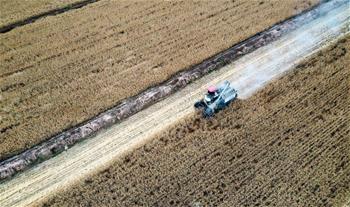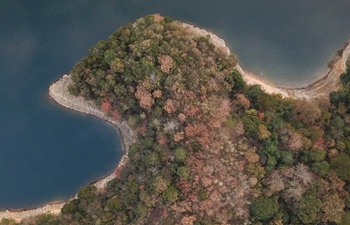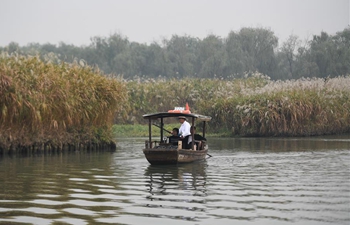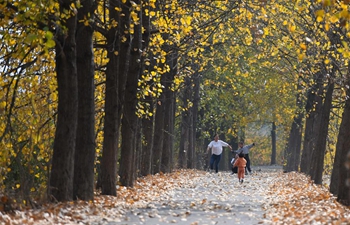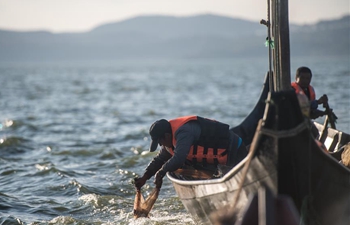by Maria Vasileiou
THE HAGUE, Nov. 6 (Xinhua) -- With climate change bringing stronger storms and rising sea levels, the Dutch give Houtribdijk, one of the low-lying country's largest flood defense dikes, a makeover with the help of soft, natural solutions used for the first time on non-tidal inland water areas.
"Traditionally the water hydraulic sector has been working on single purpose and hard engineering infrastructures to fight against flooding. In the case of Houtribdijk, the idea was to reinforce the dike by building with nature," said Fokko van der Groot, program manager at EcoShape, a Dutch consortium of engineering firms, knowledge institutions, government agencies and NGOs.
"We joined forces to study how we could incorporate nature in the project," explained the expert. "The aim was to reinforce the dike with materials provided by nature in the nearby area, to make it adaptable to changing circumstances and to enable more biodiversity."
The 20-odd km-long Houtribdijk, a dam separating IJsselmeer, a closed off inland bay, from the shallow lake of Markermeer in central Netherlands, protects the surrounding provinces against high water and serves as a road connection between the Dutch cities of Lelystad and Enkhuizen.
SANDY REINFORCEMENT
"One part of the levee is reinforced with quarry stones and the other part with wide, sandy banks. The sand was taken from the bottom of lake Markermeer," explained van der Groot.
"A sandy foreshore, which consists of a large quantity of sand that is deposited in front of a dune, has been used before to strengthen seashores. We know all aspects involved in using it in the North Sea coast. But a sandy reinforcement in such a huge non-tidal inland water environment has never been done before."
The project was highlighted earlier on Wednesday in the context of the "Amsterdam International Water Week" taking place between Nov. 4 and Nov. 8 in the Dutch capital.
To find ways to reinforce Houtribdijk in this "soft and dynamic" way, EcoShape and Rijkswaterstaat, the Dutch government's department implementing the country's Flood Protection Program, decided to set up a test site along the dike to study the behaviour of a sandy foreshore in a shallow lake environment and gradually develop the full-scale project.
"The aim was to build in the field and work a pilot solution on the spot, gaining knowledge on how to develop guidelines for the whole project," van der Groot said.
SOFT SOLUTIONS
The sandy banks along the dike absorb the waves from the Markermeer and IJsselmeer, protecting it from the power of the water.
"We put sand along the dike with vegetation on top of it. When the storm hits, the waves break on the sandy foreshore and their impact is reduced or eliminated, so they do not reach the dike, avoiding the need to reinforce it in a traditional way with new blocks or more concrete," said Stefan Aarninkhof from Delft Technical University (TU Delft).
"The dike can now withhold up to 1.5 meter waves, which come along during a very severe storm event. Using soft solutions, sand and vegetation, is cheap and dynamic. If predictions on the sea level become less optimistic we can reinforce it by adding more sand."
At the same time, the "building with nature" solution helps the diversity of the surrounding lakes and especially of Markermeer, which has been in a poor diversity state because it is surrounded by hard edges.
The Markermeer is used as a freshwater reservoir and a buffer not only against floodwaters but also droughts. When the Netherlands was hit by drought some 15 years ago and several minor dikes were endangered, water from the Markermeer was used to keep the area surrounding Amsterdam wet, thereby keeping the dikes safe.
"Shallow shores help biodiversity and they are beneficial for the lake," explained van der Groot. "Along the dike's foreshore we also created a natural bird feeding and nesting reserve."
After four years of research and development, the Houtribdijk project, due to be completed in 2020, provides knowledge on design, construction, management and maintenance of sandy foreshores in lake systems, which will be used to support decision making and design of future foreshores on other locations and under other circumstances, the Dutch expert said.

